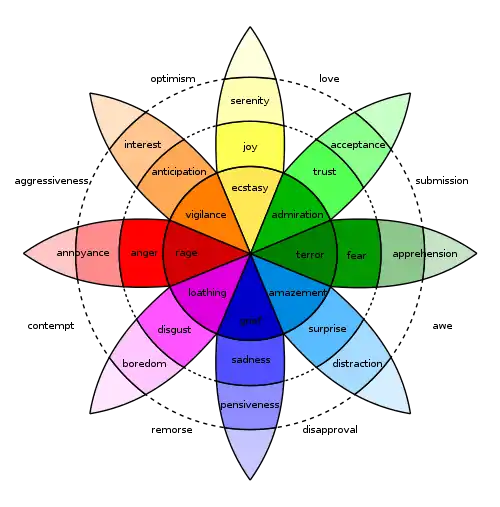Emotional lability
In medicine and psychology, emotional lability is a sign or symptom typified by exaggerated changes in mood or affect in quick succession.[1][2] Sometimes the emotions expressed outwardly are very different from how the person feels on the inside. These strong emotions can be a disproportionate response to something that happened, but other times there might be no trigger at all. The person experiencing emotional lability usually feels like they do not have control over their emotions. For example, someone might cry uncontrollably in response to any strong emotion even if they do not feel sad or unhappy.[1]
Emotional lability is seen or reported in various conditions including borderline personality disorder,[3] histrionic personality disorder,[4] hypomanic or manic episodes of bipolar disorder,[5] and neurological disorders or brain injury (where it is termed pseudobulbar affect), such as after a stroke.[6] It has sometimes been found to have been a harbinger, or early warning, of certain forms of thyroid disease.[7] Emotional lability also results from intoxication with certain substances, such as alcohol and benzodiazepines.[8] It can also be an associated feature of ADHD.[9][10]
Children who display a high degree of emotional lability generally have low frustration tolerance and frequent crying spells or tantrums.[2] During preschool, ADHD with emotional lability is associated with increased impairment and may be a sign of internalizing problems or multiple comorbid disorders.[10] Children who are neglected are more likely to experience emotional dysregulation, including emotional lability.[11]
Potential triggers of emotional lability may be: excessive tiredness, stress or anxiety, over-stimulated senses (too much noise, being in large crowds, etc.), being around others exhibiting strong emotions, very sad or funny situations (such as jokes, movies, certain stories or books), death of a loved one, or other situations that elicit stress or strong emotions.[1]
References
- Acquired Brain Injury Outreach Service (2011). "Understanding Emotional Lability" (PDF). The State of Queensland (Queensland Health). Retrieved January 6, 2017.
- Posner, Jonathan; Kass, Erica; Hulvershorn, Leslie (2014-08-19). "Using Stimulants to Treat ADHD-Related Emotional Lability". Current Psychiatry Reports. Springer Nature. 16 (10): 478. doi:10.1007/s11920-014-0478-4. ISSN 1523-3812. PMC 4243526. PMID 25135778.
- Paris, Joel (1993). Borderline Personality Disorder: Etiology and Treatment. American Psychiatric Pub. p. 106. ISBN 978-0-88048-408-4. OCLC 25281982.
- Kernberg, Otto F. (27 September 1995). Aggression in Personality Disorders and Perversions. Yale University Press. p. 58. ISBN 978-0-300-06508-4. OCLC 25965238.
- Fortinash, Katherine M.; Worret, Patricia A. Holoday (13 June 2014). Psychiatric Mental Health Nursing. Elsevier Health Sciences. p. 230. ISBN 978-0-323-29327-3. OCLC 960964818.
- Kim, Jong S. (2016-09-30). "Post-stroke Mood and Emotional Disturbances: Pharmacological Therapy Based on Mechanisms". Journal of Stroke. Korean Stroke Society. 18 (3): 244–255. doi:10.5853/jos.2016.01144. ISSN 2287-6391. PMC 5066431. PMID 27733031.
- Michelle Cassara (2002-08-20). "Hyperthyroidism" (PDF). Cite journal requires
|journal=(help) - Stark, Margaret M.; Payne-James, J. Jason (30 April 2009). Symptoms and Signs of Substance Misuse. Cambridge University Press. p. 22. ISBN 978-0-521-13727-0. OCLC 656492372.
- Cooper, Ruth E; Tye, Charlotte; Kuntsi, Jonna; Vassos, Evangelos; Asherson, Philip (2016-01-15). "The effect of omega-3 polyunsaturated fatty acid supplementation on emotional dysregulation, oppositional behaviour and conduct problems in ADHD: A systematic review and meta-analysis". Journal of Affective Disorders. Elsevier BV. 190: 474–482. doi:10.1016/j.jad.2015.09.053. ISSN 0165-0327. PMID 26551407.
- Maire, Jenna; Galéra, Cédric; Meyer, Eric; Salla, Julie; Michel, Grégory (June 2016). "Is emotional lability a marker for attention deficit hyperactivity disorder, anxiety and aggression symptoms in preschoolers?". Child and Adolescent Mental Health. 22 (2): 77–83. doi:10.1111/camh.12168. PMID 32680322. S2CID 148130518.
- Maguire, S. A.; Williams, B.; Naughton, A. M.; Cowley, L. E.; Tempest, V.; Mann, M. K.; Teague, M.; Kemp, A. M. (2015-03-03). "A systematic review of the emotional, behavioural and cognitive features exhibited by school-aged children experiencing neglect or emotional abuse". Child: Care, Health and Development. Wiley. 41 (5): 641–653. doi:10.1111/cch.12227. ISSN 0305-1862. PMID 25733080.

